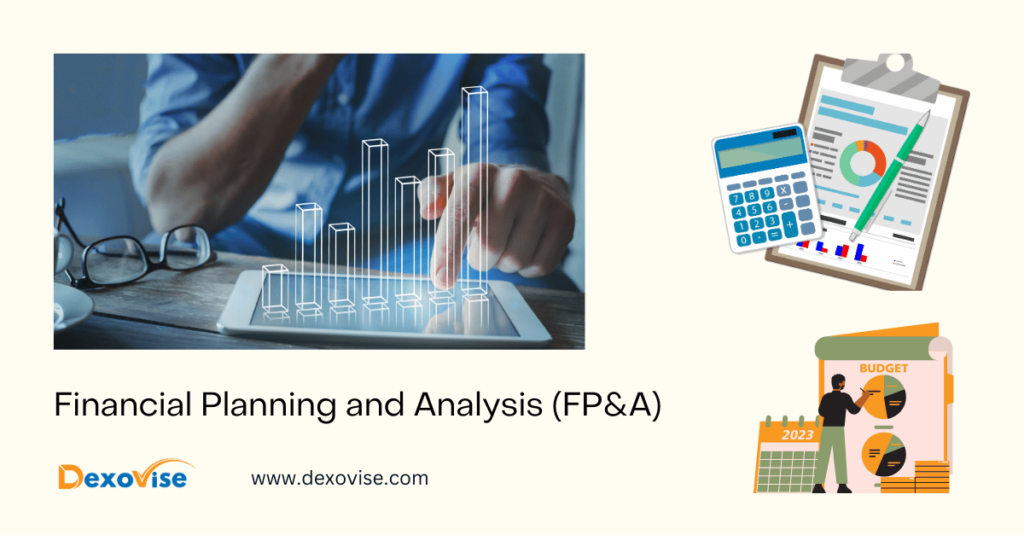Introduction
Financial Planning and analysis for modern businesses has become critical in today’s fast paced business environment. Many businesses have difficulty in integrating their organizational strategies with their financial goals which results in inefficient decision making as well as growth prospects. Financial planning and analysis (FP&A) is key for companies aiming to improve their finances and make smart choices. This guide covers the basics of FP&A, including important concepts, tools, strategies, and best practices. These can help businesses deal with financial challenges and reach their goals.Key Takeaways
- Understand the core principles and evolution of financial planning and analysis for modern businesses
- Explore the key components of FP&A and its role in driving business growth
- Discover essential tools, technologies, and strategies for effective budgeting, forecasting, and decision-making
- Learn how to develop data-driven financial models and leverage performance metrics for informed decision-making
- Gain insights into risk management, scenario planning, and implementing best practices in financial analysis
What is Financial Planning & Analysis: Core Concepts and Evolution
Financial Planning & Analysis (FP&A) is key for businesses to make smart, data-based choices. It includes budgeting, forecasting, and analyzing financial data. This helps in making strategic decisions and growing the business.
Traditional vs Modern FP&A Approaches
FP&A used to be seen as just about looking back at financial reports. But now, it’s all about looking ahead and making strategic plans. Today, FP&A uses advanced tools to give real-time insights and predict future trends.
Key Components of FP&A
- Budgeting: Creating detailed budgets that match company goals and strategies.
- Forecasting: Using past data, market trends, and industry standards to forecast future finances.
- Financial Analysis: Understanding financial data to find important insights, spot risks and chances, and guide decisions.
- Performance Management: Tracking and reporting of financial performance against budgets and forecasts
- Financial Risk Management: Process of evaluating and minimizing financial risks to maintain financial health of an organization
Role of FP&A in Business Growth
Good FP&A is crucial for business growth and success. It gives timely financial insights, helping companies make smart decisions and use resources well. This lets businesses tackle challenges, seize opportunities, and reach their goals.
| Traditional FP&A | Modern FP&A |
|---|---|
| Backward-looking, focused on historical data | Forward-looking, leverages advanced analytics |
| Siloed, departmental approach | Integrated, cross-functional collaboration |
| Rigid, static budgeting and forecasting | Agile, scenario-based planning |
Why and how is financial planning and analysis crucial?
It is important for any organization to have financial planning and analysis if it is to achieve success in financial health as well as the strategy. Thus, this model offers unambiguous strategic financial guidelines and outlooks.
The benefits of FP&A include:
- Streamlines the process: FP&A makes it easier and quicker to make budgeting and forecasting in the right manner, and makes the organizations more alert to respond to changes within the market.
- Accurately predicts future events: It enhances the overall effectiveness of forecasting, and therefore enhances the formulations of the organization’s financial plans and management of its risks.
- Makes decisions more quickly: Enables organizations to come up with quick decisions based on reliable information thus enabling them to ‘outsmart’ other rivals.
- Resources are allocated optimally: This will allow for better, more efficient utilization of resources in an attempt to maximize return on supply investment and minimize cost.
- Reduces organizational cost: Information analysis of KPIs helps make conclusion about improvement and cost-saving opportunities.
- Promotes innovation and growth: By providing financial projections and scenario analysis, FP&A helps organizations make informed investment decisions.
“FP&A is no longer just about number-crunching; it’s a strategic business partner that drives growth and shapes the future of the organization.”
Understanding the Complete FP&A Guide for Businesses
Financial Planning and Analysis (FP&A) is key to a business’s success. This guide dives deep into FP&A, covering its main parts and how they help businesses grow. At its core, FP&A connects budgeting, forecasting, reporting, and performance analysis. These work together to give a full financial view of a business.
The FP&A journey starts with budgeting, setting financial goals for the company. Next, forecasting predicts future finances based on current trends and market conditions. Then, reporting keeps everyone updated on the company’s financial health. Finally, performance analysis uncovers ways to improve and optimize.
By grasping the full FP&A guide, businesses can use their financial data better. This leads to smarter decisions that boost growth and profits. This section will explore FP&A’s various parts, giving you the skills and tools to improve your financial planning and analysis.
| FP&A Component | Key Objectives |
|---|---|
| Budgeting | Establish financial targets and resource allocation |
| Forecasting | Predict future financial outcomes and performance |
| Reporting | Communicate financial information to stakeholders |
| Performance Analysis | Identify areas for improvement and optimization |
“FP&A is not just a finance function, but a strategic business partner that drives growth and profitability.”
Essential Tools and Technologies in Modern FP&A
In today’s fast-paced business world, FP&A pros have many advanced tools. These include financial modeling software and data analytics platforms. They are changing how companies make decisions based on data.
Financial Modeling Software Solutions
Financial modeling is key in FP&A, and new software has changed this field. Tools like Excel and specialized FP&A platforms offer features for scenario analysis and forecasting. They help teams create interactive models that show a company’s financial health and future.
Data Analytics Platforms
Data analytics is also crucial in FP&A for making data-driven decisions. Platforms like Tableau and Power BI help analyze and visualize financial data. They help teams find trends, identify KPIs, and create reports that support financial planning.
Automation and AI in FP&A
Automation and AI are making FP&A more efficient and accurate. RPA automates repetitive tasks, and machine learning finds patterns in data. This lets FP&A teams focus on strategic work, leading to better business results.
“The key to successful financial planning and analysis is the strategic application of the right tools and technologies. By embracing these innovations, FP&A teams can elevate their capabilities and contribute more effectively to data-driven decision making.”
Developing Effective Budgeting and Forecasting Strategies
In today’s fast-paced business world, having a solid financial plan is key to success. Budgeting and forecasting are essential for this. They help businesses stay on track in a changing market. Here are some top strategies for reaching financial goals.
Embracing Zero-Based Budgeting
Zero-based budgeting is a new way to budget. It starts from scratch, making every expense count. This method helps businesses be more careful with money and find ways to save.
Leveraging Rolling Forecasts
Annual budgets can’t keep up with fast changes. Rolling forecasts are more flexible. They update regularly with new data, helping businesses stay quick and ready for anything.
Scenario Planning for Resilience
Scenario planning is vital in today’s uncertain world. It looks at different financial futures. This helps businesses plan for any situation, making them stronger and more ready to make decisions.
| Budgeting Technique | Key Benefits |
|---|---|
| Zero-Based Budgeting | Encourages cost-consciousness, optimizes expenses, and provides a fresh perspective on resource allocation. |
| Rolling Forecasts | Enables agility, responsiveness, and proactive decision-making in the face of changing market conditions. |
| Scenario Planning | Enhances organizational resilience and supports strategic decision-making by exploring multiple financial outcomes. |
Using these budgeting and forecasting strategies can help businesses grow and succeed. Being able to predict and adapt to changes is what sets them apart in today’s market.

Strategic Financial Planning and Decision Making
In today’s fast-changing business world, strategic financial planning and decision-making are key to success. By using financial planning and analysis (FP&A), companies can better handle strategic decision making, risk management, and business finances. This helps them make choices with more confidence and clarity.
Long-term Financial Planning
For businesses to grow big, they need solid long-term financial planning. This means forecasting future finances, spotting risks and chances, and matching investments with big goals. FP&A experts use past data and trends to build strong financial models. These models guide strategic choices and help businesses grow steadily.
Risk Assessment Methods
- Scenario analysis: Looking at how different economic, market, and operational scenarios might affect finances.
- Sensitivity analysis: Checking how financial forecasts change with shifts in key factors like sales or interest rates.
- Monte Carlo simulations: Running many tests to see how likely and big different risks could be.
Investment Decision Framework
For businesses to use their resources well and succeed over time, making smart investment choices is key. FP&A teams create detailed frameworks for investment decisions. They look at return on investment (ROI), net present value (NPV), and internal rate of return (IRR). These tools, along with good risk assessment, help companies make financial decisions that match their goals.
“Successful strategic financial planning is about finding the right balance between avoiding risks and grabbing opportunities. FP&A insights help businesses tackle these challenges with confidence and clarity.”
Mastering Cash Flow Management and Analysis
Effective cash flow management is key for any successful business. In today’s fast-changing market, it’s vital to master cash flow analysis. This skill helps keep profits up, reduces financial risks, and drives growth.
At the core of cash flow management is knowing how to manage money coming in and going out. By keeping a close eye on cash flow, businesses can spot ways to boost profitability. They can then make smart, data-backed choices to improve their financial health.
Strategies for Enhancing Cash Flow
- Implement Robust Invoicing and Collection Practices: Send out invoices on time and follow up quickly to cut down on late payments and increase cash coming in.
- Optimize Inventory Management: Keep inventory levels just right to avoid wasting money on too much stock.
- Negotiate Favorable Supplier Terms: Use your negotiation skills to get longer payment terms from suppliers, helping you manage cash going out better.
- Leverage Financial Instruments: Look into options like factoring, short-term loans, or lines of credit to cover cash flow gaps.
By using these strategies, businesses can improve their cash flow management and become more financially stable.
“Cash is king in business, and managing it effectively can make all the difference between success and failure.” – John Smith, CFO, ABC Corporation
Regular cash flow analysis and forecasting help businesses spot and fix cash flow problems early. This keeps their finances steady and ready for growth and expansion.
Mastering cash flow management is essential for financial planning and analysis (FP&A) in today’s businesses. With strong strategies and the right tools, companies can fully use their financial resources. This sets them up for long-term success and sustainability.
Performance Metrics and KPI Tracking
In today’s fast-paced business world, making decisions based on data is key to success. Performance metrics and key performance indicators (KPIs) are vital. They help measure and analyze a company’s financial and operational health.
Financial KPIs
Financial KPIs give a clear view of a company’s financial health and profit. Important financial metrics include:
- Gross Margin
- Net Profit Margin
- Return on Investment (ROI)
- Debt-to-Equity Ratio
- Liquidity Ratios
Operational Metrics
Operational metrics show how well a company runs day-to-day. Key operational KPIs are:
- Customer Satisfaction Score
- Employee Productivity
- Inventory Turnover
- Lead Conversion Rate
- Website Traffic and Engagement
Benchmark Analysis
To really get a business’s performance, comparing it to industry standards and competitors is crucial. Benchmark analysis helps spot strengths, weaknesses, and areas for growth. It guides data-driven decisions for lasting success.
| Metric | Industry Average | Your Company | Variance |
|---|---|---|---|
| Gross Margin | 35% | 32% | -3% |
| Net Profit Margin | 18% | 15% | -3% |
| Customer Satisfaction Score | 8.2 | 7.8 | -0.4 |
| Website Conversion Rate | 2.5% | 1.8% | -0.7% |
By tracking performance metrics, analyzing trends, and comparing to industry standards, businesses can make smart, data-driven choices. These choices lead to sustainable growth and profit.
Building Data-Driven Financial Models
In today’s fast-changing business world, financial modeling is key for making smart decisions. It uses advanced data analysis methods to create strong financial models. These models offer insights and help predict the future.
Creating good financial models starts with using many kinds of data. This includes past financial data, market trends, and customer behavior. By mixing these, businesses can understand their finances well and see what might happen next.
- Design Flexible Financial Models: It’s important to make models that can change with the market and business needs. This means adding flexible variables and doing sensitivity tests. It helps the model stay useful and accurate.
- Leverage Data Visualization: Using data visualization makes complex financial data easy to understand. Interactive tools like dashboards help spot trends and risks quickly.
- Incorporate Automation and AI: New tech like automation and AI has changed financial modeling. They help with data work, checking models, and reports. This makes planning and analysis better and faster.
| Financial Modeling Approach | Key Benefits |
|---|---|
| Data-Driven Financial Modeling |
|
| Automated Financial Modeling |
|
Using data-driven financial modeling helps businesses get valuable insights. It improves planning and decision-making. This leads to growth and profit.
“The true value of financial modeling lies in its ability to transform complex data into actionable intelligence, empowering businesses to navigate the ever-changing market landscape with confidence and precision.”
Risk Management and Scenario Planning
In today’s fast-changing business world, risk management and scenario planning are key to financial planning and analysis (FP&A). By spotting and handling risks, companies can make smart strategic decisions. These decisions help them grow and stay strong over time.
Risk Assessment Techniques
First, understanding the risks a company faces is crucial. FP&A experts use many methods to do this, like:
- SWOT (Strengths, Weaknesses, Opportunities, Threats) analysis
- Sensitivity analysis to see how changes affect things
- Scenario planning to look at possible futures
- Monte Carlo simulations to guess the chances of different scenarios
Contingency Planning
With a good risk understanding, FP&A teams can create strong contingency plans. These plans help lessen the effects of risks. For example, they might include:
- Finding new ways to make or get products
- Spreading out income to not rely too much on one thing
- Keeping enough cash on hand for unexpected costs
- Being able to make quick decisions when needed
Market Analysis Integration
Adding market analysis to FP&A is vital. It helps see how outside factors affect a company. By watching industry trends and economic changes, FP&A experts can:
| Metric | Importance | Insights Gained |
|---|---|---|
| Market share | See how competitive you are | Find chances to grow and threats |
| Market growth rates | Get the big picture of the industry | Help plan for the future |
| Economic indicators | Keep an eye on the big picture | Guess how demand and investment will change |
By mixing risk management, scenario planning, and market analysis into FP&A, companies can face uncertainty with confidence. They make smart, strategic choices that lead to lasting success.
“Successful companies don’t just react to changes in the market – they anticipate them and position themselves to thrive in any economic environment.”
Implementing Best Practices in Financial Analysis
Effective financial analysis needs the right practices. These ensure data is correct, teams work well together, and things keep getting better. By using these strategies, companies can improve their fp&a best practices, finance best practices, and performance analysis.
Keeping data accurate is key. This means having strong data rules, using the latest analytics tools, and checking data often. With reliable financial data, companies can make smart choices.
It’s also important to work well with other teams. FP&A should team up with operations, marketing, and HR. This helps everyone understand what drives the company’s success. It leads to better forecasting and decision-making.
Lastly, always look for ways to improve. FP&A teams should check their work often, find ways to do things better, and use new tech. This keeps financial analysis up-to-date and ready for the company’s needs.
Frequently Asked Questions- FAQs
What is Financial Planning & Analysis (FP&A)?
Financial Planning & Analysis (FP&A) is key in business. It includes forecasting, budgeting, and analyzing finances. It helps companies make smart choices and grow.
What are the key components of FP&A?
FP&A has several main parts. These are budgeting, forecasting, financial reports, and analyzing performance. Together, they give a full picture of a company’s finances and future.
How has the role of FP&A evolved over time?
FP&A used to just focus on budgeting and reports. Now, it’s about planning, managing risks, and making decisions with data. It’s become more strategic, helping businesses grow and stay agile.
What are the benefits of implementing effective FP&A practices?
Good FP&A boosts financial performance and cash flow. It helps manage risks and makes strategic decisions better. It lets companies understand their finances, find growth chances, and use resources wisely.
What are the essential tools and technologies used in modern FP&A?
Today’s FP&A relies on financial modeling software, data analytics, automation, and AI. These tools improve accuracy, efficiency, and insights in FP&A.
How can businesses develop effective budgeting and forecasting strategies?
For better budgeting and forecasting, use zero-based budgeting and rolling forecasts. Scenario planning is also key. Use historical data, industry benchmarks, and market analysis to guide your planning.
What is the role of cash flow management in FP&A?
Cash flow management is vital in FP&A. It affects a company’s financial health and ability to fund growth. Good cash flow analysis and management can boost profitability and strategic position.
How can businesses use performance metrics and KPIs to drive better decision-making?
Choosing and tracking the right KPIs is crucial. They help measure and improve business performance. Benchmarking against industry standards can reveal areas for improvement.
What are the best practices for building data-driven financial models?
Building strong financial models needs good data, scenario analysis, and clear assumptions. Quality data and advanced modeling techniques lead to accurate forecasts and informed decisions.
How can businesses integrate risk management and scenario planning into the FP&A process?
Risk management and scenario planning are key in FP&A. Companies should assess risks, plan for contingencies, and analyze markets. This prepares them for financial challenges and opportunities.










